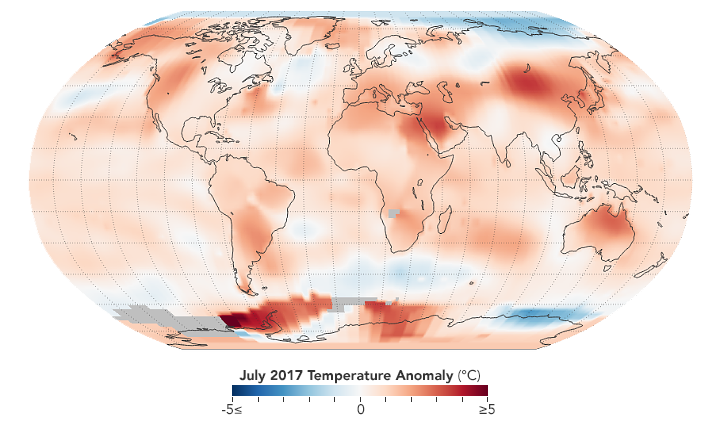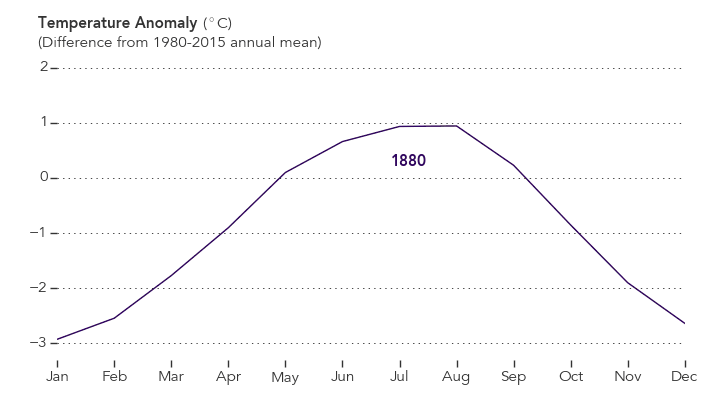



July 2017 was statistically tied with July 2016 as the warmest July in the 137 years of modern record-keeping, according to a monthly analysis of global temperatures by scientists at NASA’s Goddard Institute for Space Studies (GISS).
Last month was about 0.83 degrees Celsius warmer than the mean July temperature of the 1951-1980 period. Only July 2016 showed a similarly high temperature (0.82 degrees Celsius). All previous months of July were more than a tenth of a degree cooler.
The map above depicts global temperature anomalies for July 2017. The colors do not represent absolute temperatures; instead they show how much warmer or cooler an area was compared to the baseline average from 1951 to 1980. Note that the strongest reds are as much as 5 degrees Celsius (9 degrees Fahrenheit) above the monthly mean.
The animation shows global temperature anomalies for every month since 1880, a result of the Modern-Era Retrospective analysis for Research and Applications, version 2 (MERRA-2) model run by NASA’s Global Modeling and Assimilation Office. Each line shows how much the global monthly temperature was above or below the annual global mean from 1980–2015. Note how monthly temperature anomalies rise over the 137-year record. The long-term warming trend has been driven by rising concentrations of heat-trapping carbon dioxide and other greenhouse gases in the atmosphere.
July 2017 was about 0.83 degrees Celsius warmer than the mean July from the 1951–1980 period. July 2016 showed a similarly high temperature (0.82°C). The three previous global highs were set in 2015, 2011, and 2009.
The GISS team assembles its temperature analysis from publicly available data acquired by roughly 6,300 meteorological stations around the world; by ship- and buoy-based instruments measuring sea surface temperature; and by Antarctic research stations. This raw data is analyzed using methods that account for the varied spacing of temperature stations around the globe and for urban heating effects that could skew the calculations. There are sufficient observations from 1880 (particularly in the southern hemisphere) to produce a reasonably precise global temperature record. Prior to that, uncertainties (due to gaps in spatial coverage) increase substantially.
Meteorologists writing for The Washington Post recently reported that the average July 2017 temperature in Death Valley, California, was the hottest for any location on record on Earth. The average temperature was 107.4 degrees Fahrenheit (41.9°C), as the temperature (day or night) never dropped below 89°F degrees and ranged as high as 127°F.
Several other U.S. locations, including Salt Lake City, Miami, and Reno, set new monthly temperature records in July. Spain also posted its highest daily temperature on record when temperatures soared to 46.9°C (116.4°F) in Cordoba. And Shanghai, China, registered its highest-ever daily temperature at 40.9°C (105.6°F) in late July.
NASA Earth Observatory images by Joshua Stevens, based on data from the NASA Goddard Institute for Space Studies. Story by Mike Carlowicz.